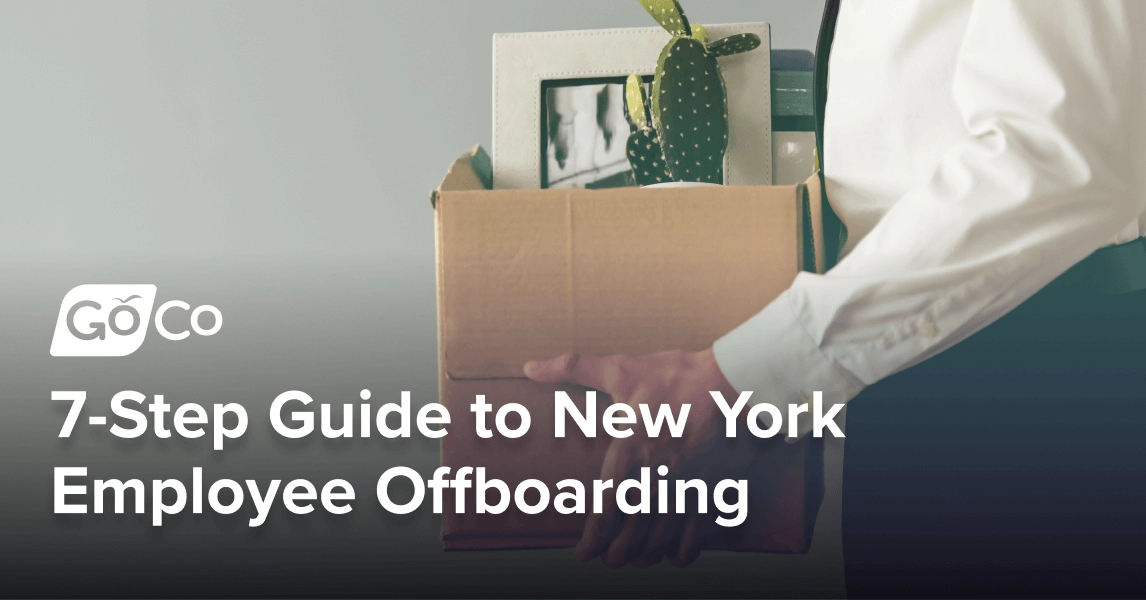7-Step Guide to New York Employee Offboarding
Key strategies for offboarding in New York to ensure compliance and create a smooth, respectful exit for employees.
September 27th, 2024
Table of Contents
- What is Employee Offboarding in New York?
- Step 1: Comply with Legal Requirements in New York
- Step 2: Notify Relevant Departments
- Step 3: Conduct an Exit Interview
- Step 4: Recover Company Property
- Step 5: Handle Final Paychecks and Benefits
- Step 6: Provide Necessary Documentation
- Step 7: Use Technology to Streamline Offboarding
- Final Thoughts: Offboarding Done Right in New York
Employee turnover is a fact of life. On average, individuals in their 50s and 60s have held about 12 different jobs throughout their careers. This emphasizes the importance of having a smooth, well-structured offboarding process. While onboarding new employees is critical, offboarding is just as essential. It allows you to end professional relationships on a positive note, gather valuable feedback, and ensure compliance with legal obligations.
For small and mid-sized businesses in New York, offboarding can seem daunting due to state-specific legal requirements and the need to protect company interests. Below, we’ve outlined clear, actionable steps to guide you through the offboarding process while maintaining compliance and ensuring your business runs smoothly.
What is Employee Offboarding in New York?
Employee offboarding refers to the process of managing the exit of an employee from your organization, whether due to resignation, termination, or retirement. This process typically includes:
Completing necessary paperwork
Recovering company property
Conducting exit interviews
Managing final pay and benefits
Ensuring compliance with New York labor laws
Having an effective offboarding process in place reduces disruptions to your business, protects sensitive information, and leaves a lasting positive impression on departing employees.
Step 1: Comply with Legal Requirements in New York
In New York, businesses must follow specific legal requirements when offboarding employees. The first step is ensuring compliance with these laws.
Provide a Written Notice of Termination
New York law mandates that employers must provide terminated employees with a written notice within 5 business days of termination. This notice should include:
The reason for termination
The effective date of termination
This notice ensures transparency and helps avoid misunderstandings. You can refer to the New York Department of Labor's guidelines for more details.
Deliver Final Pay and Wage Statements
Under New York law, final pay must be provided on or before the employee's next scheduled payday. The final paycheck should include:
Earned wages up to the last working day
Any accrued, unused paid time off (PTO)
Ensure that every paycheck, including the final one, includes a wage statement (pay stub) so employees can verify the amount.
COBRA and Benefits Continuation
If applicable, provide information regarding COBRA (Consolidated Omnibus Budget Reconciliation Act) for continued health insurance coverage. Inform the employee about the deadline to enroll in COBRA and other benefits they may continue or need to transfer.
Step 2: Notify Relevant Departments
When an employee leaves, it’s essential to notify key departments to ensure a seamless transition. This prevents delays or complications after the employee departs.
Payroll Department
Notify the payroll department immediately to calculate the employee's final pay. This includes any severance pay and unused PTO. Using payroll software that integrates with PTO tracking can help streamline this process, ensuring accuracy.
HR Department
Update your records and HR Information System (HRIS) to reflect the employee’s departure. Modern HR platforms can simplify record-keeping and ensure compliance with employment laws. Keeping accurate employee records is crucial for audits and legal reasons.
IT Department
Coordinate with your IT team to revoke the employee’s access to company systems, email, and other digital resources. This step protects sensitive data and ensures no unauthorized access after departure. Make sure IT deactivates access at the correct time to avoid any gaps in security.
Step 3: Conduct an Exit Interview
Exit interviews are one of the most valuable opportunities to gather honest feedback from departing employees. A well-structured exit interview can reveal why employees leave and help improve retention in the future.
During the interview, ask open-ended questions, such as:
- What prompted your decision to leave?
- What did you enjoy about working here?
- Were there any challenges or areas for improvement?
Encourage the employee to share their insights openly. Use the feedback to identify recurring issues and areas where the organization can improve. Don’t treat the exit interview as a mere formality — it’s a tool for your company’s long-term improvement.
Step 4: Recover Company Property
When an employee leaves, retrieving company property is essential to protect your assets. Items to collect include:
Laptops, phones, tablets
ID badges, keycards, uniforms
Files, documents, and intellectual property
Create a checklist to track all assets issued to the employee and ensure their return before the last working day. If any items are missing or damaged, document the issue, and request reimbursement if necessary. Keeping an organized process for property recovery will help prevent lost equipment and ensure security.
Step 5: Handle Final Paychecks and Benefits
Handling final pay and benefits correctly is crucial, both to meet legal requirements and to maintain a good relationship with the departing employee.
Final Pay
New York requires employers to issue a final paycheck by the next regular payday, which should include:
All earned wages up to the final day
Any unused vacation time or PTO
Refer to the New York Department of Labor to ensure your final pay practices comply with state regulations.
Benefits Continuation
Discuss benefits like health insurance (via COBRA), life insurance, and retirement plans. Provide the employee with deadlines and instructions for continuing health coverage or transferring retirement funds. Make sure they have all necessary paperwork, including information about enrolling in COBRA.
Step 6: Provide Necessary Documentation
It’s essential to provide all relevant documentation related to the employee’s departure. This includes:
COBRA details and deadlines for health insurance continuation
Documentation for any 401(k) or retirement plan transfers
A final termination letter summarizing the terms of the exit
If your employee is subject to non-compete or confidentiality agreements, remind them of their obligations and provide copies of those documents. This helps protect your company’s interests even after the employee departs.
For companies with larger layoffs, be aware of the Worker Adjustment and Retraining Notification (WARN) Act, which requires 90 days’ notice for mass layoffs. Failing to provide appropriate notices could lead to legal consequences.
Step 7: Use Technology to Streamline Offboarding
Managing offboarding manually can be overwhelming, especially for small businesses with limited resources. HR automation tools can help streamline the offboarding process by:
Automatically disabling system access
Generating exit documentation
Tracking returned assets and final payments
These tools help small and mid-sized businesses maintain compliance with New York labor laws while making the offboarding process smoother and more efficient. Automating routine tasks also reduces the chance of human error and frees up your HR team for more strategic work.
Final Thoughts: Offboarding Done Right in New York
Though often overlooked, offboarding is just as important as onboarding. It helps maintain compliance, protect company interests, and improve your organization based on employee feedback. By following these steps, you can make offboarding a seamless process that ensures your business continues to operate smoothly while maintaining positive relationships with departing employees.
By partnering with a trusted HR software provider like GoCo, you can streamline your offboarding process, ensure compliance, and create a positive experience for departing employees. We invite you to book a demo with us to learn how our powerful HR solutions can help you navigate the complexities of employee offboarding in New York. Let us show you how we can simplify your HR processes, so you can focus on what matters most – your people.
Recommended Posts
New Hire Paperwork and Compliance for New York
Blog Articles
Top 9 Employee Benefits Trends To Watch for in 2025
Blog Articles
Search...
Product
GoCo
Resources
Articles
eBooks
Webinars
Customer Stories





